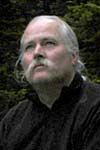First, three examples of when a cubic is much better than a cylinder. In the cubic version be sure to look up!
- fullscreen size:
- Yosemite Falls: cylindrical or CUBIC
redwood forest: cylindrical or CUBIC
skyscrapers: cylindrical or CUBIC
- standard size:
- Yosemite Falls: cylindrical or CUBIC
redwood forest: cylindrical or CUBIC
skyscrapers : cylindrical or CUBIC
These are all replacements, and there are more to come. There will also be some big updates in the near future that will have lots of cubics - such as San Francisco. The remaining replacements (cubic for cylindrical) are mostly in Yosemite and the deserts of Southern California.
More About Cubics
In the beginning QTVR was limited to a cylindric imaging model - you could look all the way around, but only a little bit up and down. It was new and exciting and for many subjects it worked well. Eventually Apple extended the technology to support a cubic (i.e. spherical) view, so you could look straight up and straight down, as well as all the way around. It was a whole new generation of amazing, crowd pleasing computer graphics.
But there were trade-offs. The VR file either had to be bigger to show a larger view, or if bandwidth was an issue, you had to reduce resolution. If there was really nothing up there but more blue sky, or down below but dirt or grass, why reduce resolution? So for most landscape subjects I stuck with the cylindrical view.
Another issue was the software. The first really good VR panorama production environment was Apple's QuickTime VR Authoring Studio, which only did cylinders. The two main programs that did cubic stitching had severe problems: PanoTools was ridiculously cumbersome to use; RealViz Stitcher was expensive and quirky and it was hard to get good results. I wasted a lot of time with those two programs, and only ever produced a few good cubics.
But some subjects just had to have more vertical field of view - cliffs, forests, tall buildings, deep canyons. Beginning in 2001 I was shooting multi-row cubics even though I wasn't finishing and posting any on the site.
I finally got started with cubic stitching a year ago, using PTMac. But there were still quality and efficiency issues, a lot of time spent manually assigning control points and retouching stitching problems in Photoshop. The breakthrough came when the program PTGui was ported to the Mac, with automatic control point generation that actually worked. Paired with CubicConverter it makes an excellent cubic panorama production system. Receomended.
I already had hundreds of cubics lined up ready to go. It took several months to work my way through, setting up the files then running the batch stitcher overnight. Then I had to examine each one, and sometimes make adjustments and stitch again. When I had a good stitch there still was some obligatory Photoshop work. So it has been about a year in progress, but now I am finally able to put these cubics on the site.
Some of these have never been posted before, but most are replacing a cylindrical version. In some cases I probably shouldn't have put up the cylinder in the first place, like my Yosemite waterfalls with the top cut off. But usually I offered a cylinder as a placeholder until I could produce a cubic.
Now I shoot cubics routinely and process the cylinders and cubics all together in the same workflow. For maximum quality I sometimes use a multi-tier approach (shooting a level tier, a tier up and another down), but usually I shoot cubics with a fisheye lens, a fast and efficient procedure.
Some VR photographers sneer at cylinders as being old-fashioned and inadequate. I disagree, and still shoot about 80% cylinders . They have a few inherent advantages - higher resolution from the same camera, easier to deal with certain types of moving objects, and more appropriate for printing "unwrapped". If there is important scene detail up above or down below, I put on the fisheye and shoot a cubic. But if there is just more sky and dirt, or if I see potential for a print, I still use a normal wide angle lens to make a cylinder. My cubics tend to be concentrated in certain landscape types - forests, canyons, and cities. Sometimes I shoot a cubic to capture a great cloud-scape.
As of today 164 cubics have been placed on the site to replace cylinders, with another 100 coming to finish the job (mostly Yosemite and the deserts of Southern California). Panoramas taken over the last year, and from now on, will be a mix of cubics and cylinders.

1 comment:
Don,
I agree with your viewpoint not every panorama needs to be cubic. The one thing I did notice for the cubic of Upper Yosemite First view was the difference is download time - even on broadband. Looking at file size - the cylindrical was 1177Kb versus 3948Kb for Cubic! That explains the time lag. Being a co-WWP contributor - do you really need that size for cubic view? I am sure you sensitive to the the person who is still on dial up services.
This was my first visit to your blog site - really enjoyed reading your entries and behind the lens stories!
richard
Post a Comment